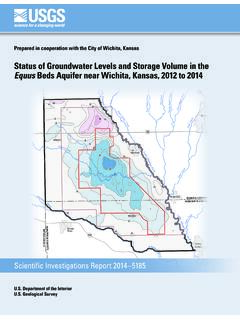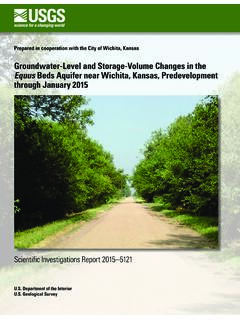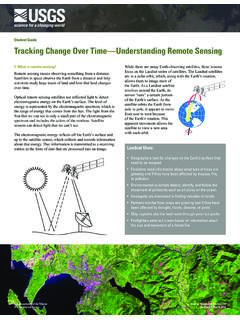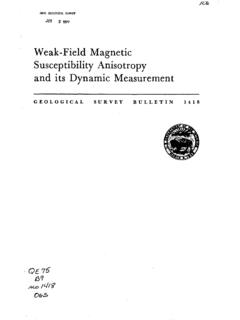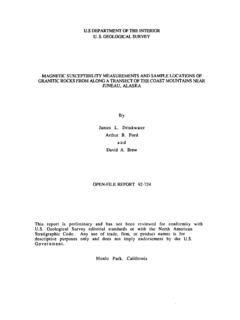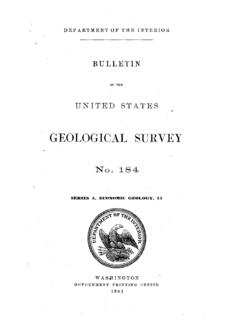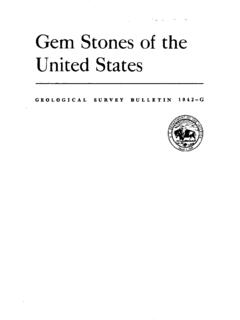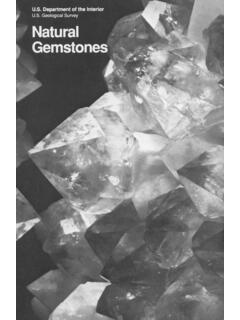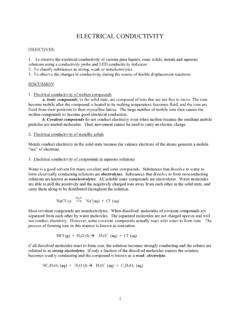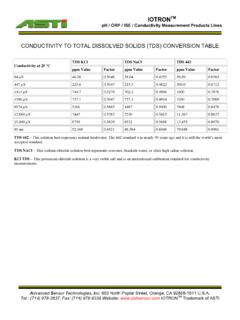Transcription of Specific Conductance: Theoretical Considerations and ...
1 Specific conductance : Theoretical Considerations and Application to Analytical Quality ControlUnited States Geological SurveyWater-Supply Paper 2311 Specific conductance : Theoretical Considerations and Application to Analytical Quality ControlBy RONALD L. MILLER, WESLEY L. BRADFORD, and NORMAN E. GEOLOGICAL SURVEY WATER-SUPPLY PAPER 2311 DEPARTMENT OF THE INTERIOR DONALD PAUL MODEL, GEOLOGICAL SURVEY Dallas L. Peck, DirectorUNITED STATES GOVERNMENT PRINTING OFFICE: 1988 For sale by the Books and Open-File Reports Section, Geological Survey, Federal Center, Box 25425, Denver, CO 80225 Library of Congress Cataloging in Publication DataMiller, Ronald LSpecific conductance .( Geological Survey water-supply paper ; 2311)Bibliography: : I :23111. Water quality Measurement.
2 2. Water Electric properties- Measurement. 3. Electric conductivity Measurement. I. Miller, Ronald L. II. Peters, Norman E. III. Title. IV. Series: Geological Survey water-supply paper 1986 86-600214 CONTENTSA bstract 1 Introduction 1 Theory of Specific conductance 1 Electrical resistance and conductance 1 Definition of conductivity 2 Potassium chloride secondary standards 2 Temperature effects and instrumental temperature compensation 3 Ionic conductance 6 Concentration relationships 7 Temperature relationships 8 Effects of complexation and protonation 9 Applications to analytical quality control 10An empirical approach in natural waters 10 Tests of the empirical model 11 Adjustments for effects of complexation 11 Calculation of the sum of conductance and the exponential correctionfactor (f)
3 11 Evaluation of/ 11 Quality control checks 12 Comparison of measured with computed Specific conductance andanions with cations 12 Predicting the sum of anions or cations 13 A special case for seawater and estuarine waters 13 Notes on Specific conductance measurements 14 Instrumentation 14 Procedures 14 Summary 15 References 15 FIGURES1-5. Graphs showing:1. conductivity -temperature relationships for N KG solution and 1 per mil chlorinity seawater 42. Percentage change in conductivity with temperature for N KC1 solu- tion and seawater in 1 C increments 53. Values of the ratio of Specific conductance to conductivity for N KG solution and 1 per mil chlorinity seawater 64. Decreases in equivalent conductance of selected electrolytes with increas- ing concentration 85.
4 Changes in limiting equivalent conductivity of selected ions with temperature 9 Contents IIITABLES1. conductivity of secondary standard potassium chloride (KC1) solutions 32. Comparison of conductivity of N KC1 solutions (in jiS/cm) converted to SI units 33. Comparison of the ratio KS/K predicted by dividing jiS/cm (at 25 C) by the conductance calculated using equation 9, equation 10, and calculated using data from Rosenthal and Kidder (1969) and Harned and Owen (1964) 74. Values of KS/K for N KG solutions in 1 C increments calculated bydividing jiS/cm (at 25 C) by the conductance calculated using equation 9 75. Limiting equivalent conductances (\ ) of selected ions 106. Stability constants (log K,) for ion associations between major inorganic ions in natural waters at 25 C 107.
5 Statistical summary of exponential correction factor (f) values 118. One standard-deviation range of estimated KS using (XC, * \ / 129. Relationship of the/value and anion ratios (p equals the probability of accept- ing the null hypothesis, H0 ; correlation coefficient r=0) 1210. Algorithms for calculating conductivity , Specific conductance , chlorinity, and salinity of seawater and estuarine water 14IV ContentsSYMBOLS[All units are absolute as defined by Le Systeme International d'Unites (SI) (American Society for Testing and Materials, 1976), except as noted. The conversion of conductivity values from a base of the international ohm to the absolute ohm (the SI system) is made by multiplying by Equations in which the symbol appears are in parentheses.]A Cross-sectional area of a conductor or conducting solution (cm3) (2,3,4)A,B,a,b,c Empirical proportionality constants (13,14,15)or Fraction of salt dissociated in solution (11)or, Fraction of the constituent / present as the free ion (12,17,18,20)C Concentration of a salt in solution in equivalents/liter (N) or moles/liter (M)(7,12,13,14,15) C, Concentration of ion i in solution in milliequivalents/liter (meq/L)(17,18,20,27,28)Cy* Concentration of ion i after accounting for complexation (meq/L) (25,27) E Electrical potential in volts (joules/coulomb) (1) ff Resistivity of a conductor (ohm cm) (2,3,4) 7 Activity coefficient of an ion in solution/ Exponential correction factor defined by equation 20 (20,25,26,28))
6 Fj Fraction of major ions that are monovalent using concentrations in milli-equivalents per liter (26) ^ Viscosity of the solvent (water); also used as an empirical constant in someequations (15) I Ionic strength of a solution (1/2 2 C^8) where Q is expressed in molal units(moles/kilogram of solvent) (16)/ Electrical current in amperes (coulombs/second) (1) K Cell constant of a measurement device (5,6,30) Kj Stability constant for a complexation reaction (19,21,22,23,24) x conductivity of a solution in Siemens/centimeter (S/cm) or microsiemens/ce-ntimeter (,uS/cm) at a temperature other than 25 C (4,8,9,10,12,30) /e; Specific conductance of a solution, conductivity (K) at 25 C(7,10,17,18,20,25,28)A? conductivity of a standard solution (6) xm Measured conductivity of a standard solution (6) L Length of a conductor (cm) (2,3,4) Mobilities of ions in solution (11) A Equivalent conductance of a salt in solution at 25 C; the conductance perchemical equivalent of a salt at concentration C.
7 The equivalent conductivity (A*) at 25 C (in ftS/crn per meq/L) (14,15) A* Equivalent conductivity of a salt in solution at a temperature other than 25 C (13)A * Limiting equivalent conductivity of a salt in solution, the equivalent conduc- tivity (A*) at infinite dilution (13) A Limiting equivalent conductance of a salt in solution, the limiting equivalentconductivity (A0*) at 25 C (14,15)AA Average equivalent conductance for a water sample (27,28) &i Equivalent conductance of ion i; the conductance per chemical equivalent ofion at concentration Q; the equivalent conductivity (\i*) at 25 C ( p-S/cmper meq/L) (16,17) /ly* Equivalent conductivity of ion i in solution; the equivalent conductance (\4)at a temperature other than 25 C (12)Symbols VA/ Limiting equivalent conductance of ion i, the limiting equivalent conductivity (V*) at 25 C (16,18,20,25,27)M** Concentration or activity of a divalent metal cation (19,21)R Resistance of a conductor or solution (ohms) (30)R " Resistance of a standard solution (ohms)Rm Measured resistance of a standard solution (ohms)T Temperature in degrees Celsius ( C)X*~ Concentration or activity of a divalent anion (19,21)Zj Charge on the ion iVI SymbolsSpecific conductance : Theoretical Considerations and Application to Analytical Quality Control y Ronald L Miller, Wesley L Bradford, and Norman E.
8 PetersAbstractThis report considers several Theoretical aspects and practical applications of Specific conductance to the study of natural review of accepted measurements of conductivity of secondary standard N KCI solution suggests that a widely used algorithm for predicting the temperature varia- tion in conductivity is in error. A new algorithm is derived and compared with accepted measurements. Instrumental tem- perature compensation circuits based on N KCI or NaCI are likely to give erroneous results in unusual or special waters, such as seawater, acid mine waters, and acid approach for predicting the Specific conductance of a water sample from the analytically determined major ion composition is described and critically evaluated. The model predicts the Specific conductance to within 8 percent (one standard deviation) in waters with Specific conductances of 0 to 600 /iS/cm.
9 Application of this approach to analytical quality control is conductance is one of the most frequently measured and useful water-quality parameters. Instru- mentation now available, appropriate standard solutions , and simple procedures allow measurements to be made easily in the field or laboratory with 95 percent or better accuracy. Specific conductance correlates with the sum of dissolved major-ion concentrations in water and often with a single dissolved-ion concentration (Hem, 1970). Thus, it usefully supplements analytical determination of major ions. Specific conductance can also be used for quality- control checks on laboratory determinations of major ion report discusses several aspects of electrical conductance in aqueous solutions , including variation with temperature and dissolved-ion concentration and the abil- ity of current theory to describe these variations.
10 A new algorithm for describing the changes in conductivity with temperature in a standard solution is derived and tested. The report also presents and evaluates an empirical model for estimating the Specific conductance from ana-lytically determined concentrations of the major ions. Methods are suggested for use of measured and esti- mated Specific conductance in analytical quality control. Finally, the report offers suggestions and precautions on the measurement of Specific conductance in natural OF Specific CONDUCTANCEE lectrical Resistance and ConductanceOhm's Law is typically writtenE=i R,where(1)E electrical potential, in volts (joule/cou- lomb),i= electrical current, in amperes (cou- lomb/second), andR= resistance, in ohms (joule * second/cou- lomb2 ).The resistance of a conductor is directly propor- tional to its length (L) and inversely proportional to its area (A).
